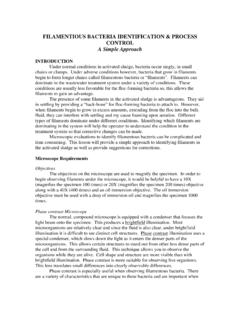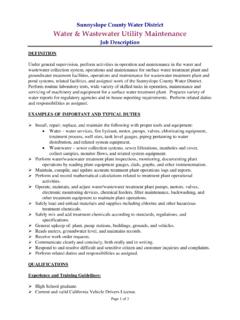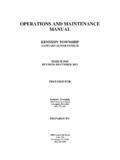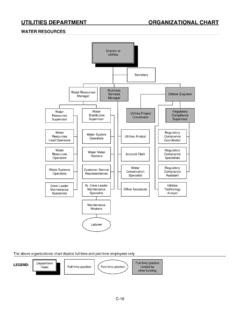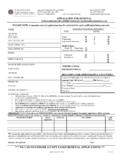Transcription of The wastewater treatment process is a biological …
1 INTRODUCTION Volumes of wastewater termed sewage are generated from many different sources. This sewage represents thousands of tons of organic matter. Why microbiology? wastewater treatment is a biological process ! A wastewater treatment plant is a microbiological zoo that houses bacteria, protozoa, metazoa and other microlife. The microorganisms do the actual breakdown and removal of nutrients and organic material in the wastewater . Like you and I, they perform best when all their needs are met (food, pleasant environment etc.). wastewater treatment facilities are designed to allow the natural process of the breakdown of pollution to occur under controlled conditions.
2 These systems include physical and chemical processes to remove solids and heavier materials. However, left behind is the liquid containing soluble and insoluble organic material. The one process all sewage facilities have in common is the biological treatment of this organic material or nutrients . That is, they rely on the use of certain microorganisms to convert these organic nutrients into materials that are beneficial for the environment. Sewage contains nutrients of every type; phosphorus, nitrogen, sodium, potassium, iron, calcium and compounds such as fats, sugars and proteins. Microorganisms use these substances as a food source for energy, for the synthesis of cell components and to maintain life processes.
3 It is the task of the operator to provide a favorable environment for the microorganisms. The operator provides the food and the favorable environment and the microorganisms do the work of removing nutrients and providing wastewater treatment . The health and well being of these microorganisms are critical to the adequate treatment of sewage. Many types of microorganisms can be found in the wastewater treatment system. However, the types of organisms that will dominate will be the ones that are best suited to the environment or conditions in the system. wastewater treatment systems are designed to foster an environment that suits a certain type of microorganism.
4 These microorganisms not only remove organic wastes from the water, but they also settle out as solid material for easy removal. wastewater treatment operators are required to maintain the right conditions in the treatment system for the right type of microorganisms. If the right conditions are not present, the wrong microorganisms will dominate. These wrong microorganisms not only interfere with the successful removal of wastes from the water, but they themselves may be difficult to remove from the system. MICROSCOPY The wastewater treatment process is a biological process , therefore in order to properly evaluate this process you need to use biological tools The Tool: Microscope The human eye is not capable of distinguishing objects with a diameter less than mm.
5 Bacteria have a diameter of approximately mm. In order to view their activity we must use a microscope. An ordinary light microscope consists of: A microscope stand A specimen stage (where the slides lies) A nosepiece (holds the objectives) Oculars (eyepieces) A condenser A light source The Objectives: 10 X objective (magnifies 100 times) 20 X objective (magnifies 200 times) 40 X objective (magnifies 400 times) 100 X objective (magnifies 1000 times) this is the oil immersion lens and must be used with immersion oil. NosepieceObjectivesStageLight SourceAdjustmentKnob CondenserOculars Under normal operation, light rays from a light source are passed through the condenser, which directs the rays through the specimen.
6 This produces a brightfield illumination. However, most of the microorganisms found in wastewater are transparent. This makes it difficult to distinguish cell structures since the water is also transparent. There are several microscopy techniques that enable us to see clear and distinct cell structures. Phase Contrast enables you to see internal structures. Phase contrast illumination uses a special condenser, which slows down the light as it enters the denser parts of the microorganisms. This allows certain structures to stand out from other less dense parts of the cell and from the surrounding fluid. This technique allows you to observe the organisms while they are alive.
7 Cell shape and structure are more visible than with brightfield illumination. Phase contrast is more suitable for observing live organisms. This lens translates small differences into clearly observable differences. Another technique called darkfield microscopy makes the microorganisms appear white while the background appears black. The light does not pass through the specimen but hits only the sides of the specimen. There are several other microscopy techniques but those I mentioned are the most common used in the wastewater laboratory. Darkfield displays the background as black and the organisms white Slide Preparation Wet Mount A wet mount is used to examine live microorganisms.
8 Cell measurements and cell shape can be determined. Place a drop of a well-mixed representative sample on a clean grease-free slide. Place a clean cover glass is on top. Avoid entrapment of air as much as possible. The size of the drop is critical. If the drop is too big the cover glass will float. If the drop is too small the sample will dry up too quickly. Use a pipette with a small opening. Fixed Smears & Staining Wet mounts are used to examine live cell structure and motility. Stains reveal different properties. In order to stain a sample it must be fixed to the slide so that it will not wash off during the staining process . Place a drop of sample on a clean, wax-free slide and smear across the slide.
9 Let the slide air-dry. DO NOT HEAT FIX! Once the sample is dried completely, it is ready for staining. The two most common sample techniques are simple staining and differential staining. Simple staining uses only one stain. The differential stain uses more than one stain and dyes different types of microorganisms different colors. The different colors may be based on inclusions within the cells or differences in how the cell wall is structured. These stains help to distinguish between organisms, which would otherwise be difficult to tell apart. The most common differential stain is the Gram stain. The Gram stain divides bacteria into two groups, 1) Gram-positive, those bacteria that retain the crystal violet and stain purple and 2) Gram-negative, those bacteria that lose the crystal violet color when rinsed with alcohol and stain pink with the counter stain safranin.
10 Gram stain solutions can be purchased in kits already made up. The Gram stain procedure is done in 4 steps using 4 different solutions. Make sure that when you stain, you are staining the side of the slide with the smear on it. Gram Stain Procedure: 1. Completely cover the smear with crystal violet solution and let stand for 1 minute. Gently wash with water. At this point both the gram-positive and gram-negative bacteria are stained purple. 2. Completely cover the smear with iodine solution and let stand for 1 minute and gently wash with water. A crystal violet-iodine complex is formed that helps the gram-positive bacteria to hold on to the purple dye.
